OverviewDS31256 has 256 independent direcTIonal HDLC channels, which support up to 64 T1 or E1 data streams. Sixteen channelized or unchannelized ports and each channelized port can handle one, two, or four T1 or E1 lines. There are also three fast ports on DS31256, which can handle up to 52 Mbps in both transmit and receive direcTIons, suitable for HSSI or clear channel T3 applicaTIons. All sixteen ports can operate from zero to 10 Mbps when configured in unchannelized mode of operations. Types of T1 / E1 ApplicationsThere are two types of channelized T1 and E1 applications: The first type is where a single T1 or E1 data stream is routed to and from one of the sixteen physical ports of the DS31256. This first type is represented as a thin arrow (Figure 1) in the application examples and the electrical connections are shown in Figure 2. The second type is where four T1 or E1 data streams have been Time Division Multiplexed (TDM) into a single 8.192MHz data stream, which is routed to and from the DS31256. This second type is represented as a thick arrow in Figure 1 and the electrical connections are shown in Figure 3.

Figure 1. Application drawing key.
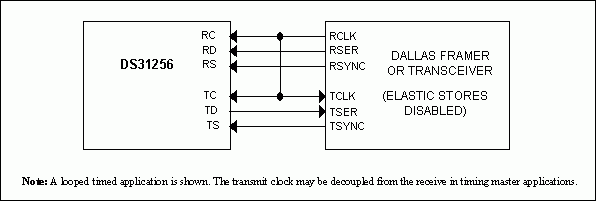
Figure 2. Single T1 / E1 connection.
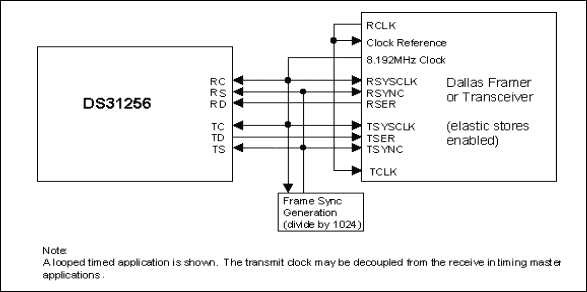
Figure 3. Quad T1 / E1 connection.
An application shows where 16 T1 or E1 links are framed and interfaced to a single DS31256. The T1 lines can be either clear-channel or channelized. The DS26528 Octal T1 / E1 / J1 single-chip transceiver performs the line interface function and frames to the T1 / E1 / J1 line.
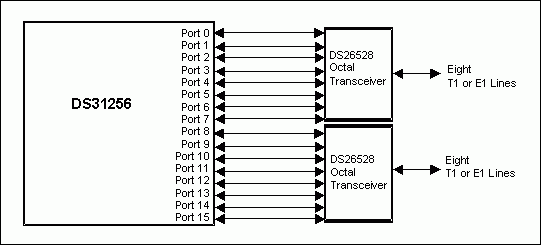
Figure 4. 16 Port T1 application.
An application shows where two T3 lines are interfaced to a single DS31256. The T3 lines are demultiplexed by DS3112 M13 devices and passed to the DS21FF42 4 x 4 16-channel T1 framer and DS21FT42 4 x 3 12-channel T1 framer devices. The T1 framers locate the frame and multiframe boundaries and interface to the DS31256 by aggregating four T1 lines into a single 8.192MHz data stream, which then flows into and out of the DS31256. The T1 lines can be either clear channel or channelized.
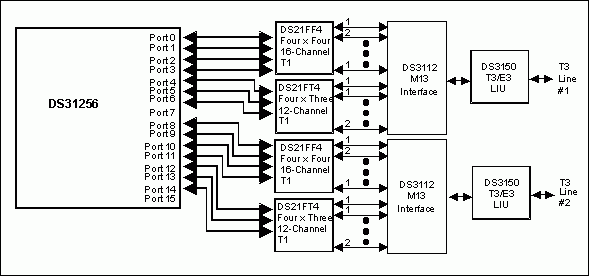
Figure 5. Dual T3 with 256 HDLC channel support.
An application shows where a T3 line is interfaced to two DS31256s. The T3 line is demultiplexed by the M13 block and passed to the DS21FF42 and DS21FT42 devices. The T1 framers locate the frame and multiframe boundaries and interface to the DS31256. Aggregating four T1 lines into a single 8.192MHz data stream is not required since the DS31256 has enough physical ports to support the application, but aggregation could be done to cut down on the number of electrical connections between the DS31256 and the T1 framers. The T1 lines can be either clear channel or channelized.
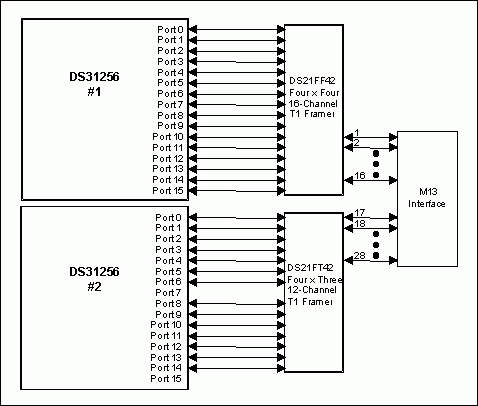
Figure 6. Single T3 with 512 HDLC channel support.
An application shows where a fully channelized T3 line is interfaced to three DS31256's. The T3 line is demultiplexed by the M13 block and passed to the DS21FF42 and DS21FT42 devices. The T1 framers locate the frame and multiframe boundaries and interface to the DS31256. Aggregating four T1 lines into a single 8.192MHz data stream is not required since the DS31256 has enough physical ports to support the application, but aggregation could be done to cut down on the number of electrical connections between the DS31256 and the T1 framers. The T1 lines can be either clear channel or channelized.
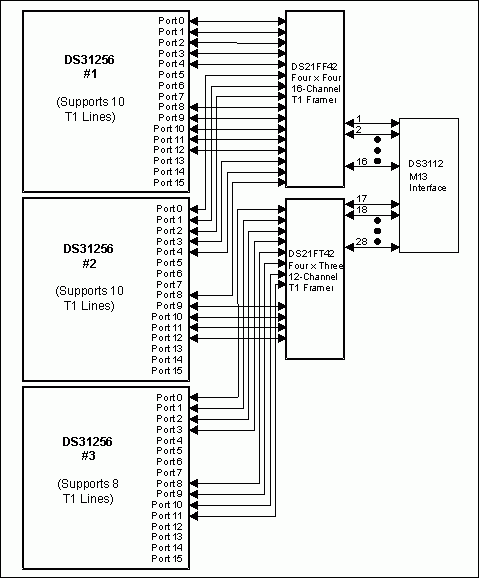
Figure 7. Single T3 with 672 HDLC channel support.
If you have further questions about our HDLC controller products, please contact the Telecommunication Applications support team via email var name = "telecom.support @"; var domain = "dalsemi.com"; document.write ("" + name + domain + ""); telecom. or call 972-371-6555.
Usb Mini Fan, a ideal design for both outdoor or in office or at home. You don`t need to worry about the high temperature in summer when you have this Mini Fan . As a mini fan, you can take it in your bag to anywhere. And it can cool you down when you are hot.
Strong wind and no noise: The Mini Handheld Fan uses a brushless DC motor to provide strong wind while quiet, energy-saving and stable operation. The maximum rotating speed of the fan is about 3520 rpm which is enough to keep you cool, works by accelerating airflow, low noise, giving you a cool and wonderful summer.
Adjust speed: Our mini Portable Fans have 3 adjustable speeds, press the power button repeatedly to adjust the appropriate fan speed you need.
With USB cable: USB port rechargeable, powered by lithium polymer battery, our Mini Usb Fan comes with usb cable which can be charged with computer, power bank , mobile power and other devices.
Ideal design and portable solution: The size of the mini handy fan is 206*85*235mm, easy to take.
Usage: Including outdoor using, you also can use this Handheld Fan in office or at home to put it on the desk. With low noise and smooth wind, others will be not disturbed.
Mobile phone holder: This handy mini desk fan is also a mobile phone holder when put on the desk or table. Small body, big power, enjoys the cool summer and gentle wind at anytime and anywhere.
Usb Mini Fan
Usb Cooling Fan,Mini Desk Fan,Mini Portable Fan,Portable Usb Fan
SHENZHEN HONK ELECTRONIC CO., LTD , https://www.honktech.com
